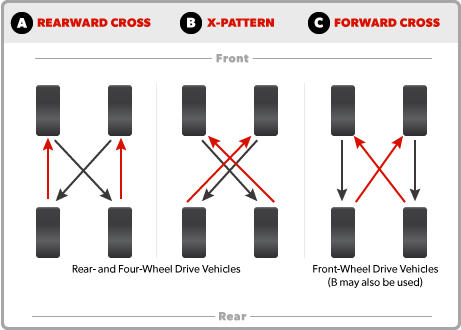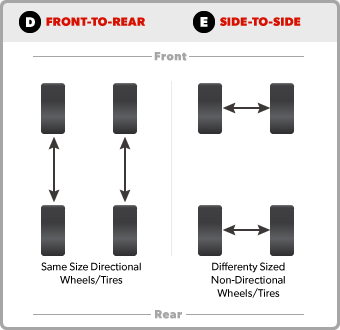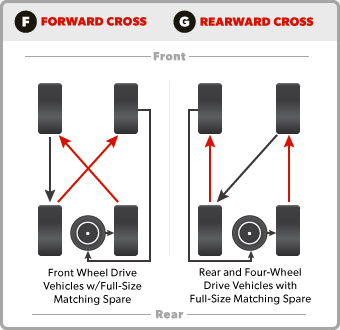I’m a relatively new owner, and close to trie rotation time, is there a collective best practice for rotation on my M3 RWD. I have seen different suggestions for front to back on same side, or cross the two when going to front, etc. What’s the popular method here?
Welcome to Tesla Motors Club
Discuss Tesla's Model S, Model 3, Model X, Model Y, Cybertruck, Roadster and More.
Register
Install the app
How to install the app on iOS
You can install our site as a web app on your iOS device by utilizing the Add to Home Screen feature in Safari. Please see this thread for more details on this.
Note: This feature may not be available in some browsers.
-
Want to remove ads? Register an account and login to see fewer ads, and become a Supporting Member to remove almost all ads.
You are using an out of date browser. It may not display this or other websites correctly.
You should upgrade or use an alternative browser.
You should upgrade or use an alternative browser.
Tire rotation best practices?
- Thread starter Jadedcause
- Start date
Shelburne
Member
I can't remember the details, but I think there is a specific rotation patter for RWD cars and a different one for AWD cars, so make sure you go with the right pattern
3sr+buyer
Active Member
https://www.tirerack.com/tires/tiretech/techpage.jsp?techid=43 describes several methods of tire rotation.


As a practical matter, pattern D is probably the easiest for most DIY situations (and may be the only option if the tires have directional tread). Moving tires to the opposite side of the car usually makes less difference in terms of evenness of tire wear than moving between front and rear.
If you keep a full size matching spare tire, then crossing patterns would be needed to have the spare wear evenly with the other tires.



As a practical matter, pattern D is probably the easiest for most DIY situations (and may be the only option if the tires have directional tread). Moving tires to the opposite side of the car usually makes less difference in terms of evenness of tire wear than moving between front and rear.
If you keep a full size matching spare tire, then crossing patterns would be needed to have the spare wear evenly with the other tires.

Tire rotation is especially beneficial on single-axle driven cars (RWD or FWD) that devour tire tread on the axle that transmits the torque to the road, than the free-rolling ones. In RWD case it means that rear tires will wear out at (2+x) rate of the fronts.I’m a relatively new owner, and close to trie rotation time, is there a collective best practice for rotation on my M3 RWD. I have seen different suggestions for front to back on same side, or cross the two when going to front, etc. What’s the popular method here?
No matter which pattern you choose for rotation, the key is getting rear tires to the front, and fronts to the rear.
Tesla recommends rotating tires every 10K km or 6,250 miles. BMW recommends tire rotation every 5,000 to 7,500 miles on 2WD vehicles. But those are just mileage guesstimates for "average" drivers. The key is monitoring tire wear for the way YOU drive in YOUR environment, and rotating them front<->back whenever the wear discrepancy creeps in above ~2-3/32nds per axle.
I switch between summer and winter tire'n'wheel sets 2x / year, so the rotation logic is super simple - take the two (2) freshest tires and put them on the rear axles, and the other two (2) go on the front axle. If the tires have directional thread, there is only one side for them to go onto (automatic method D from post above). If not-direction, then it doesn't matter. Same logic applies to RWD and AWD cars.
If I only had one (1) set of wheels and tires, I would go with method D, purely because I can jack one side of the car and swap the tires in one go per side. The entire rotation exercise will be finished in under 15 minutes, not including beer breaks. And the wheel nuts will be torque properly, exactly to spec, on every wheel.
Which is way quicker than the time it would take to drive to the nearest tire shop or SC, never minding waiting for them get on with the job. Then re-torqueing the nuts properly once you get home, since the shops/SC guerillas will either over-torque them with an air gun, or barely screw them on.
HTH,
a
Florida53
Member
Do you use two jacks or is there a jack point midway between the wheels?Tire rotation is especially beneficial on single-axle driven cars (RWD or FWD) that devour tire tread on the axle that transmits the torque to the road, than the free-rolling ones. In RWD case it means that rear tires will wear out at (2+x) rate of the fronts.
No matter which pattern you choose for rotation, the key is getting rear tires to the front, and fronts to the rear.
Tesla recommends rotating tires every 10K km or 6,250 miles. BMW recommends tire rotation every 5,000 to 7,500 miles on 2WD vehicles. But those are just mileage guesstimates for "average" drivers. The key is monitoring tire wear for the way YOU drive in YOUR environment, and rotating them front<->back whenever the wear discrepancy creeps in above ~2-3/32nds per axle.
I switch between summer and winter tire'n'wheel sets 2x / year, so the rotation logic is super simple - take the two (2) freshest tires and put them on the rear axles, and the other two (2) go on the front axle. If the tires have directional thread, there is only one side for them to go onto (automatic method D from post above). If not-direction, then it doesn't matter. Same logic applies to RWD and AWD cars.
If I only had one (1) set of wheels and tires, I would go with method D, purely because I can jack one side of the car and swap the tires in one go per side. The entire rotation exercise will be finished in under 15 minutes, not including beer breaks. And the wheel nuts will be torque properly, exactly to spec, on every wheel.
Which is way quicker than the time it would take to drive to the nearest tire shop or SC, never minding waiting for them get on with the job. Then re-torqueing the nuts properly once you get home, since the shops/SC guerillas will either over-torque them with an air gun, or barely screw them on.
HTH,
a
thesmokingman
Active Member
Directional tires dictate the path of rotations, which is to maintain the tires directional orientation. Plainly, that's front to back, etc etc, and never criss cross. Check your tires to confirm whether they're directional, if directional front to back, if not either or.I’m a relatively new owner, and close to trie rotation time, is there a collective best practice for rotation on my M3 RWD. I have seen different suggestions for front to back on same side, or cross the two when going to front, etc. What’s the popular method here?
Do you use two jacks or is there a jack point midway between the wheels?
One jacking point will do. Either front or rear will raise both wheels off the ground.
I don't bother with jack stands unless I plan to keep the car in the air for a reasonable length of time, or will be going under it for any reason. Tire rotation doesn't require either.
1. Crank all 10 lug nuts 1/2 turn loose before you lift the car.
2. Lift with a jack to get both wheels off the ground.
3. Remove both wheels, roll them around to the new locations.
4. Install them and reinstall the lug nuts on with a 12V/14V/18V/20V impact wrench. Mine zaps them to ~100 lb. ft.
5. Lower the car, and torque 10 lug nuts to 129 lb. ft.
6. Repeat the above for the other side.
One jacking point is easier than the other (I think rear suspension has more travel, so jacking at the rear jacking point will get fronts off the ground sooner than the reverse), but I keep forgetting and re-learning that each time I work on the car.
a
Last edited:
Nice, thanks, Done !One jacking point will do. Either front or rear will raise both wheels off the ground.
I don't bother with jack stands unless I plan to keep the car in the air for a reasonable length of time, or will be going under it for any reason. Tire rotation doesn't require either.
1. Crank all 10 lug nuts 1/2 turn loose before you lift the car.
2. Lift with a jack to get both wheels off the ground.
3. Remove both wheels, roll them around to the new locations.
4. Install them and reinstall the lug nuts on with a 12V/14V/18V/20V impact wrench. Mine zaps them to ~100 lb. ft.
5. Lower the car, and torque 10 lug nuts to 129 lb. ft.
6. Repeat the above for the other side.
One jacking point is easier than the other (I think rear suspension has more travel, so jacking at the rear jacking point will get fronts off the ground sooner than the reverse), but I keep forgetting and re-learning that each time I work on the car.
a
High perf summer and all season, CROSS.
Winter front to back only, DO NOT CROSS, look at the arrows!
Sorry, it's not that simple.
What you are implying is one type of tires are all directional, and the other is asymmetric. Those distinctions are not driven by the category of tires (summer vs. winter). Rather, it's very tire model specific:
Town Fair Tire - Difference Between Directional And Asymmetrical Tires
An article describing the difference between directional and asymmetrical tires.
Many do not rotate at all. They replace tires in pairs when worn.
Only rotate if they notice uneven wear across the tire.
Yep, that's an option. Just not a very good one.
Especially with the cars that have one driven axle (e.g.: RWD), the rear tires wear at an accelerated rate.
That leaves you shopping for a set of 2 tires that are always old. So if you want to upgrade to a newer and better tire, you end up with a mismatched set, which always produced exciting handling and hydroplaning outcomes.
And even if you are OK with riding on old model tires forever, there is an added issue of having tires on one axle with significantly different tread depth than the other axle. The inevitable outcome from that is uneven traction in the between two ends of the car. This is a good recipe for rapid underwear discoloration.
Not rotating tires is definitely possible, just not desirable.
If Tires wear more in center, decrease tire pressure
If tires werr more on edges, increase tire pressure.
It's not that simple, at least not since we switched from bias to radial tires in 1940s.
Front vs. rear tires perform different tasks, are aligned differently, and the resulting wear patterns are different. More here:
Been doing seasonal tire changes for closet to 20 years on Audis, WV, Volvo, SAAB, Honda, Subaru and Tesla. My tires were always like that.Sorry, it's not that simple.
What you are implying is one type of tires are all directional, and the other is asymmetric. Those distinctions are not driven by the category of tires (summer vs. winter). Rather, it's very tire model specific:
Town Fair Tire - Difference Between Directional And Asymmetrical Tires
An article describing the difference between directional and asymmetrical tires.townfairtire.com
I missed if this info is stated, but is there a benefit when rotating tires on the Performance Y where there are different sized tires in front and back. I see the chart says to move side to side but does that really help with wear?
No, not really. And not at all possible if tires are directional.
When the car has staggered front vs. back tires, rotation goes out the window. Which is why many folks strongly prefer "square" (same tire size on all four corners) tire setups.
a
Similar threads
- Replies
- 0
- Views
- 283
- Replies
- 6
- Views
- 2K
- Replies
- 7
- Views
- 2K


